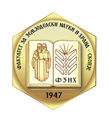MECHANICAL PLUM PRUNING
Keywords:
plum, variety, efficiency, cuts.Abstract
The most common method of plum tree pruning is a traditional method, by using manual or pneumatic shears or loppers. The persistent labor shortage imposes the need to mechanize this work operation. Preliminary results of mechanical plum pruning during the dormant period are presented in the paper. The research was performed in the orchard of the company “Agrovoće” Laktaši (Bosnia and Herzegovina) on the varieties Stanley, Čačanska lepotica and Čačanska rodna. All varieties were grafted on seedlings Prunus cerasifera Ehr. and trained in spindle system with a planting distance of 4.0 × 1.8 m. Pruning was done by hedging both sides with a saw-bar, while the tops were trimmed by hand from the platform. The research analyzed the efficiency of the pruning, the quality of cuts made during mechanical pruning, as well as the reaction of pruned trees regarding the formation of new growths during vegetation. Combined pruning (mechanical and manual) was significantly more efficient than manual pruning. The quality of mechanical pruning was largely conditioned by the varietal specifics of the tree architecture. No anomalies were found in the healing of wounds made during mechanical pruning. Activation of new vegetative shoots was more uniform in relation to manual pruning with a tendency to form a fruit-bearing wall. Mechanical pruning must be combined with manual pruning, which is necessary in regulating the top parts of the canopy as well as growth in the in-row space.



